Drafting Double Masters 2022

I can’t praise enough how well-constructed the Masters sets are for Limited. While there’s something to be said for the truly organic Limited sets, Masters sets provide more power and more familiar cards, and in some cases, many of our favorite archetypes are redesigned with a high power level. It’s a new experience from nostalgic cards, and it doesn’t get much better than that.
Here’s some stuff you should know going into your Double Masters 2022 drafts, which are only a couple weeks away. I am eagerly awaiting the release.
Two picks when you open a pack
Double Masters 2022 is unique in that you take two cards from your opening pack and every pack you open in general. This leads to a few scenarios with pick-one-pack-one. For instance, let’s say you open two extremely powerful rares, but they don’t overlap in any way.
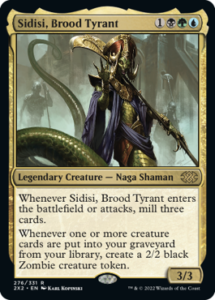

In scenarios where the power-level dropoff is enormous, you should take both rares and stay open. For example, you open Sidisi, Brood Tyrant, and Aurelia, the Warleader. It’s going to be difficult to support both of these cards in your deck, however they’re both powerful, so taking both and staying open for a few picks before you lock in is totally reasonable.


On the other hand, let’s say you open those rares and also something like a Mulldrifter or Skinrender at uncommon. At that point I think it’s better to take Sidisi and the uncommon and semi-lock in. While these cards may be slightly weaker, they allow you to be more flexible and send a strong signal to the person who will be feeding you later. If you get this kind of signal yourself, it’s best to understand what is going on and give what you’re taking. You can still abandon your first two picks if a strong signal is sent, but don’t give up on your strong cards early if there’s not a strong signal to do so.
Since the set is filled with gold cards at every rarity, seeing which ones are available after the first half-dozen picks or so will be a huge indication as to what’s open and what direction to push. You could be in three colors, but you could focus more on Golgari than Simic, for example. I often end up in three-color decks in these formats because a lot of the powerful gold cards steer you in that direction, and the fixing and power level is usually good enough to pick something up from your main two colors.
Speaking of fixing…
There’s a Cryptic Spires in every Draft Booster
This is a neat design space where instead of basic lands, they’re adding Cryptic Spires to every draft booster. You can choose any two colors for these lands. This is like an Evolving Wilds in every booster.

This has a ton of draft implications as we get three wild card dual lands per player at the table. This is a ton of fixing, but also, a lot of competition for them because they’re flexible. It’s not like if you’re the only one playing any Rakdos you’re going to get the Rakdos Duals, too.






While aggressive decks will steer clear of playing too many, the mopier three- and four-color decks will want to take these a bit more highly. It’s an interesting dilemma when to take these because there are so many and you just want a few to enable splashes along with other potentially better fixing. While there isn’t much in the set, there are the Ravnica Bouncelands. These lands are good even if they’re only one of your colors as they are card advantage. They produce two mana for one card, so any deck with higher cost cards will want to pick them up.


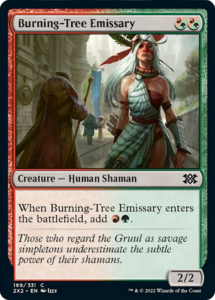

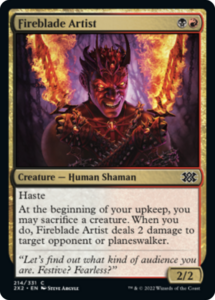

The format has a lot of aggressive commons, such as Tenth District Legionnaire, Burning-Tree Emissary, Fireblade Artist, Monastery Swiftspear, and some aggressive-leaning mechanics like Heroic and Prowess. There’s even Rift Bolt at common, Lightning Bolt and Lighting Helix at uncommon, so there’s also reach on top of it all. You don’t want to be too clunky in your mana base since you’ll need mana to keep up with these fast starts.


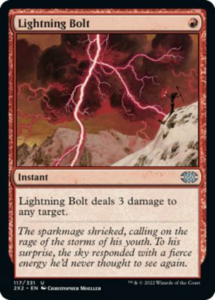

Like a normal draft, you’ll want to take these lands over replacement-level commons, behind strong uncommons and rares, and in some cases, over some stronger commons. In general, I’d probably take them behind the stronger commons because you’ll always have opportunities to get them if you have a pack to open. The trick is knowing what the replacement level is in this format. This is a masters format, so you have to throw your old heuristics from a card-by-card basis out the window and look at the cards within the context of the format.
I would have never taken a Rakdos Guildate over an Auger Spree in original Return to Ravnica, but Auger Spree is more of a replacement level now as it’s generally going to be worse than Eyeblight’s Ending. The spells are also a little better, and creatures are a little more efficient. The line is blurrier, and it will take some experience in the format to know what the cut-off line is for when a common is better than replacement level.
Because there are so many of these lands, it’s important to read the table and figure out when to pick them up. It’s nice that if a pack is dry in your colors, there’s always an on-color dual to pick up.



Because there’s so much fixing in this format, specifically because of Cryptic Spires, it’s going to be important to learn the limits of each archetype and how to branch out. If you open powerful rares and lock in but are getting cut beyond the point of switching out, figure out how you can push splashes to get the card quality and quantity you want.
We also have the old Ravnica Bouncelands coming back, which is another reason to be enticed by splashing. Don’t forget these lands will also facilitate playing less lands as they produce more mana.
The Interaction
As I look through this format, there’s a lot of interaction. There’s instant-speed removal, up and down the rarity ladder, that costs one-to-three mana. These are the types of formats I love to be creative in. Between Lightning Bolt, Rift Bolt, Stagger Shock, Disfigure, Go for the Throat, Agony Warp, Path to Exile, Eyeblight’s Ending, Auger Spree and more, there are a lot of ways to keep yourself alive and at parity with a slower control deck. I love to go big in these formats.
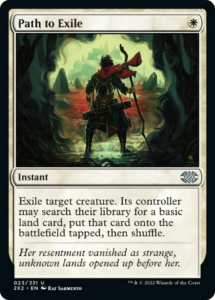





Notably there are no hard counterspells in the format outside of Mana Drain at Mythic Rare and Force of Negation at Rare. There are Mana Leak and Spell Pierce at common, but beyond that, you’re almost always going to resolve your spells. This makes overcosted, hard-to-beat bombs stronger than other formats that have cards like Cancel because you’ll know when you can resolve what you want. You can reliably work towards your top end as a game plan.
I’ll have to wait until I play games since there’s so much removal, but my intuition is combat tricks will be poor as you’ll be left stranded with a low-impact card deep into games. Burn looks relatively appealing to me, though. With Swiftspear, Fireblade Artist, Rift Bolt, and a solid sacrifice theme, Rakdos Burn is the first aggressive deck I’m looking to try out.
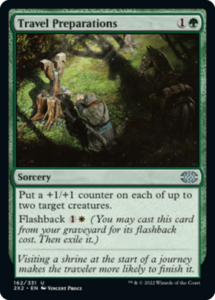

I’m not looking at Heroic much because of the aforementioned issues with combat tricks. G/W Counters will also suffer from a deck-chaining removal. Cards like Travel Preparations can get really big quickly in multiple places, so you can size up and win off of one unchecked threat.
Synergies
Much like every draft format, you can look at the gold card to understand the theme of most of the colors and what you should be trying to draft. That said, the power level of individual cards is so high, I expect to mostly be drafting “good stuff” midrange decks. While I’m sure I’ll draft some sub-themes of Self-Mill or some GW Hardened Scales/Travel Preparations decks, I’m not sure how the creature synergies can hold up to decks full of removal and rares. Self-mill with something like Spider Spawning circumvents this, so I’m more interested in seeing how this holds up.
I love Master’s sets and when the set does come out, I fully intend to write about my experiences. I will be off next week taking my family on a camping trip. When I return, hopefully I’ll have been able to draft some and be able to offer insight into the format.
See you then!
Image Copyright: (c) 1995-2020 Wizards of the Coast LLC, All Rights Reserved








